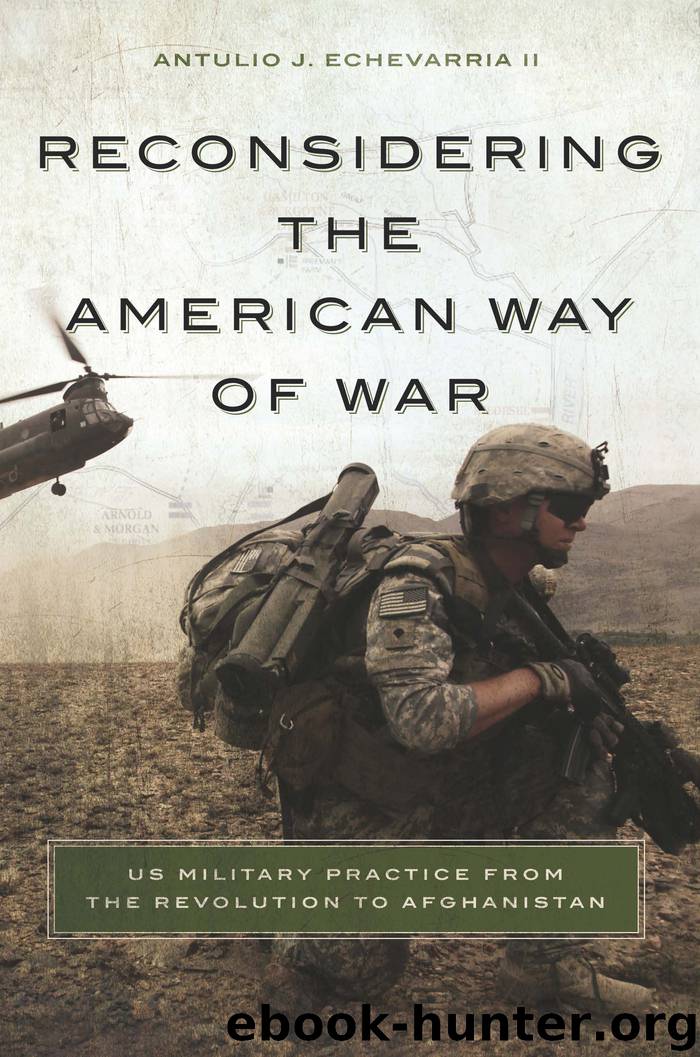Reconsidering the American Way of War by Echevarria Antulio J

Author:Echevarria, Antulio J.
Language: eng
Format: epub
Publisher: Georgetown University Press
Published: 2014-03-14T16:00:00+00:00
6
The Caribbean Wars to the Korean War
War is an art and as such not susceptible of explanation by fixed formula.
George S. Patton Jr., “Success in War” 1931
Plans are worthless, but planning is everything.
Dwight D. Eisenhower, “Remarks to the National Defense Executive Reserve Conference” 1957
BY THE MIDDLE OF THE TWENTIETH CENTURY, American military practice drew from at least two articles of faith. The first was captured in George S. Patton Jr.’s statement that war is an art and not reducible to a formula. The second was reflected in President Dwight D. Eisenhower’s pointed remark about the relative value of plans and planning.1 Both statements were contradictory. War has always been more than an art, and Patton, despite his claims, repeatedly reduced it to a simple formula or secret of success—in this case, the warrior’s determination to “conquer or perish.”2 As America’s interventions in the Caribbean and Mexico showed, Patton’s formula still worked under the right conditions. Bold action by small but determined forces could carry the day. In fact, more Medals of Honor were awarded, per capita, for such actions in the Philippines, China, and Mexico than in either world war.3 In Eisenhower’s eyes, war planning was a continuous process, an operational science, and he considered it more valuable than the product, the war plan, which rarely survived contact with the enemy. However, by 1957, war plans and campaign plans had grown important in a sense altogether obscured by Eisenhower’s well-traveled comment.4 For better or worse, the war plan—not strategy—did the real bridging between policy aims and the use of force to achieve those aims.5 The purpose of the war plan was to identify the “devil in the details,” to analyze the situation, and to establish specific military objectives, as well as tasks and subtasks pursuant to accomplishing the lofty aims of policy.
By way of illustration, a major campaign plan such as Operation Overlord linked the mission, derived from the governing strategy of the war, to the forces available to accomplish it, their logistical requirements, and the timing and sequencing of supporting and follow-on operations. In a word, the war plan became the practical face of strategy. Without it, no strategy could be put into effect. The rub was not whether a given plan might be flawed or outdated—it invariably would be in some way. Rather, it was to arrive at a consensus on actual policy aims so the branches and sequels of the plan could be worked. It was partly for this reason that Gen. Colin Powell and Defense Secretary Caspar Weinberger later articulated the Powell-Weinberger doctrine, which made “clear” policy goals a prerequisite for undertaking military action.6 Without such guidance, military planners were apt to set about pursuing military victory directly. Contrary to conventional wisdom, military strategy did not disappear in the twentieth century. Instead it became embedded in the “concept of maneuver”—the heart of the war plan.
Download
This site does not store any files on its server. We only index and link to content provided by other sites. Please contact the content providers to delete copyright contents if any and email us, we'll remove relevant links or contents immediately.
| Automotive | Engineering |
| Transportation |
Whiskies Galore by Ian Buxton(41880)
Introduction to Aircraft Design (Cambridge Aerospace Series) by John P. Fielding(33064)
Small Unmanned Fixed-wing Aircraft Design by Andrew J. Keane Andras Sobester James P. Scanlan & András Sóbester & James P. Scanlan(32743)
Craft Beer for the Homebrewer by Michael Agnew(18140)
Turbulence by E. J. Noyes(7936)
The Complete Stick Figure Physics Tutorials by Allen Sarah(7307)
Kaplan MCAT General Chemistry Review by Kaplan(6867)
The Thirst by Nesbo Jo(6828)
Bad Blood by John Carreyrou(6552)
Modelling of Convective Heat and Mass Transfer in Rotating Flows by Igor V. Shevchuk(6391)
Learning SQL by Alan Beaulieu(6211)
Weapons of Math Destruction by Cathy O'Neil(6146)
Man-made Catastrophes and Risk Information Concealment by Dmitry Chernov & Didier Sornette(5921)
Digital Minimalism by Cal Newport;(5664)
Life 3.0: Being Human in the Age of Artificial Intelligence by Tegmark Max(5474)
iGen by Jean M. Twenge(5366)
Secrets of Antigravity Propulsion: Tesla, UFOs, and Classified Aerospace Technology by Ph.D. Paul A. Laviolette(5309)
Design of Trajectory Optimization Approach for Space Maneuver Vehicle Skip Entry Problems by Runqi Chai & Al Savvaris & Antonios Tsourdos & Senchun Chai(5011)
Pale Blue Dot by Carl Sagan(4912)
